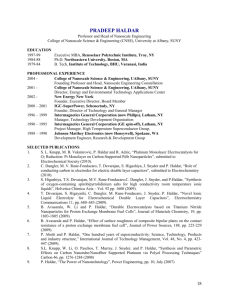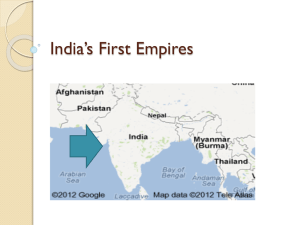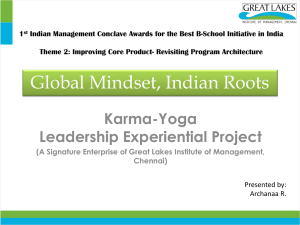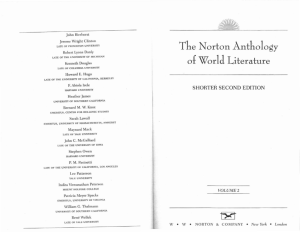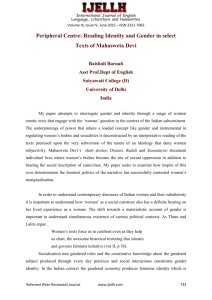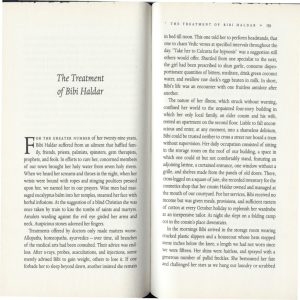Mahasweta Devi`s - Colorado Mesa University
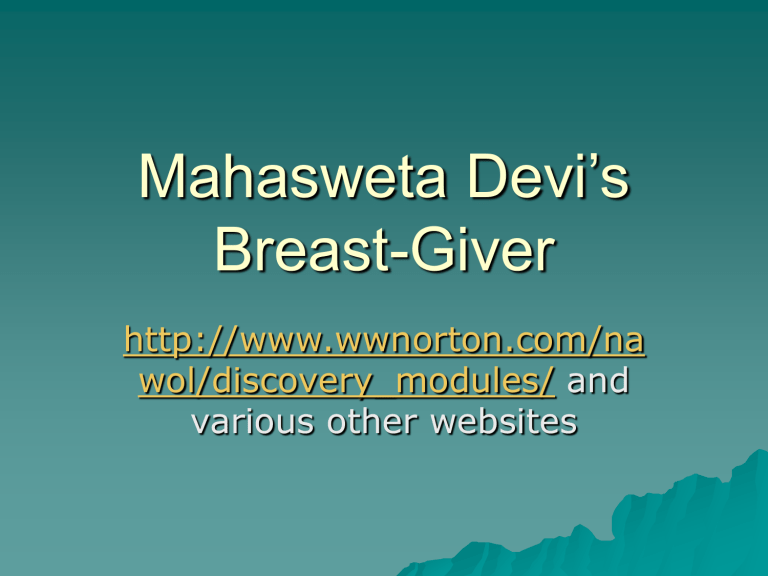
Mahasweta Devi’s
Breast-Giver
http://www.wwnorton.com/na wol/discovery_modules/ and various other websites
Quiz
1. How does Kangali lose his legs and feet?
2. How does the Lionseated appear to Joshoda in her dreams while Kangali is in the hospital?
3. What solution does Haldar’s second son find for keeping his wife beautiful and “fruitful,” in terms of bearing children? (
4. Why does Joshoda have 20 children? How does this tie in with her professional life?
5. When, approximately, does Joshoda die? (What decade?)
6. Of what does Mrs. Haldar die?
7. Where does Joshoda stay when it becomes evident that she is quite ill? Who takes care of her?
8. Who does Joshoda think is taking care of her in the hospital?
9. List two questions you have about the story.
Some Info . . .
Lion Seated Goddess
Another Image
Lion Seated Goddess, often seen with a lotus in one hand and a shaft of wheat in the other, is associated with wisdom and eroticism.
Shakti is the mother goddess. Like Shiva, she can be either beneficial or fierce, depending on her form. As
Parvati she is depicted as a beautiful woman in middle age.
As Kali she is a giantess with black skin, a blood-red tongue, and large tusks.
Kali carries an assortment of weapons and wears a garland of human skulls around her neck. The mother goddess thus stands for all aspects of nature from birth to death.
Western Influences Criticized
Breast-Giver finds fault with a kind of materialism that seems specifically Western in its forms and origins. By attaching brand names like
Studebaker to the artifacts for which the Halders
(and by extension, Indian society) have corrupted themselves, Mahasweta signals the degree to which the importation of the colonizers' values have eroded whatever ethical proprieties might once have guided families like the Haldars.
The second son who wants to preserve his wife's beauty while propagating more children on her body exults in the solution provided by Jashoda's milk: "Way found" to keep the Haldar wives in
"blouses and bras of 'European cut'".
Question
The conclusion of Breast-Giver suggests that modernity, brought about by contact with the West, has torn the old social fabric that had sustained the Hindu experience. Discuss the imagery of the disconnected phone, the hospital morgue, and "the death of God". How would you characterize Mahasweta's view of her society's relation to the colonial experience.
Questions
Writing in Bengali, Mahasweta uses English words and phrases to highlight the clashing assumptions that bedevil postcolonial existence.
(Those words italicized in the text, were in
English in the original text.) The simple response would be to think that she was thereby underlining the difference between the inauthentic impositions of imperial England and the native virtues that have managed to survive occupation.
What is the impact of the narrative's use of
English-language words? What kind of words are
"welkin" and "bodkin"? Contrast their contribution to the texture of the story with that of words like
"epidemic" and "mammary gland“. What different aspects of the colonial experience do these linguistic borrowings represent?
Is this all?
Does she only critique the inauthenticity of Western values?
What or who else does she critique?
Critique of Hindu Pieties
Mahasweta's story takes direct aim at the most sacred of inherited Hindu pieties.
From beginning to end, the author spares no one. Naming her protagonist after the iconic mother of the god Krishna, she seems at first to invite pity for her
Jashoda's hard life, but the last lines of the story make a brutal assertion that requires readers to reassess whatever sentimental notions they may have entertained about the "professional mother's" plight.
Critique of Patriarchal Structures
A feminist as well as a Marxist, Mahasweta widens the scope of her narrative as she criticizes the hypocrisy of the Indian male intellectuals who profess to value female virtues:
Even those who . . . wish to slap current posters to the effect of the "eternal she" -“Mona Lisa"-"La
Passionaria"-"Simone de Beauvoir," et cetera, over the old ones and look at women the way that way are, after all, Indian cubs. It is notable that the educated Babus desire all this from women outside the home. When they cross the threshold they want the Divine Mother in the words and conduct of the revolutionary ladies.
The process is most complicated.
Question:
How does Jashoda's presence in the
Haldar household transform the behavior of the men of the house? Discuss the concluding paragraphs to Chapter 2 of
Breast-Giver, analyzing the way in which
European ideas influence the behavior of the daughters and daughters-in-law who take advantage of Jashoda's professional assistance.
Religious Beliefs are a target, too.
Performing ritual observances, such as a pilgrimage to the temple of Durga, makes them oblivious to the social problems that surround them. Jashoda's hapless husband, Kangalicharan the Brahmin, ekes out an existence by cooking for the visitors to the Lionseated goddess's temple, who pride themselves on their proper reverence for the Brahmin and, Breast-Giver seems to imply, therefore take no responsibility to improve the life of their impoverished neighbors. Like the popular comic books that render Indian epics and mythologies accessible to the unlearned, a trivialized appeal to tradition satisfies the pilgrims' spiritual needs.
Two more questions
Why does the marriage of Kangali and Jashoda disintegrate? Discuss their quarrels (p. 277). In what sense has the traditional Indian family been undercut by Jashoda's integration into the
Haldar family?
How important is the Indian caste system to the characters in this story? How does the narrative treat the traditional reverence for
Brahmins? Would you attribute the tone taken toward Hindu social customs to the influence of
Western values?
One more . . .
How would you describe the attitude toward the body and bodily functions in
Breast-Giver ? Of what does Mrs. Haldar die? How are the physical infirmities suffered by Jashoda and Kangali described? Do you think this attitude is typically Indian, or influenced by India's colonial inheritance, or does it simply reflect the author's sensibility?
National Allegory?
Could you match the characters in the story to the events in Indian History that I shared earlier?
Is Mr. Haldar, for example, the British East India
Company? Mrs. Haldar, then, the Queen? Does
Jashoda represent India-as-exploited by colonizers and various factions within India? Do
Kangali and the various sons and daughters represent those factions – Sikhs, non-British principalities, Christians, Hindus, westernized
Indians, etc?
Then we see Jashoda’s victimization and her complicity in it in a more political way, maybe?

